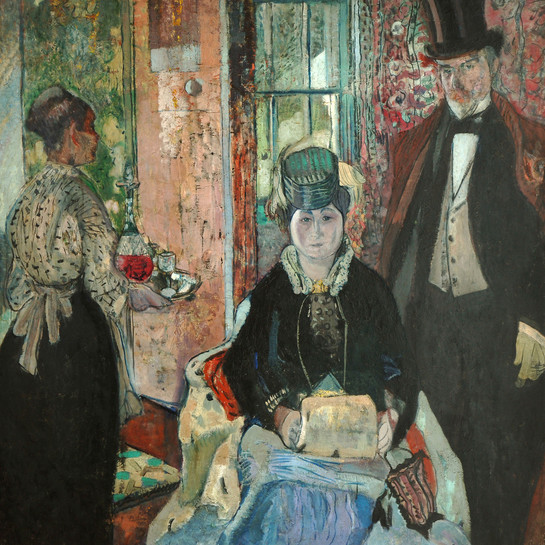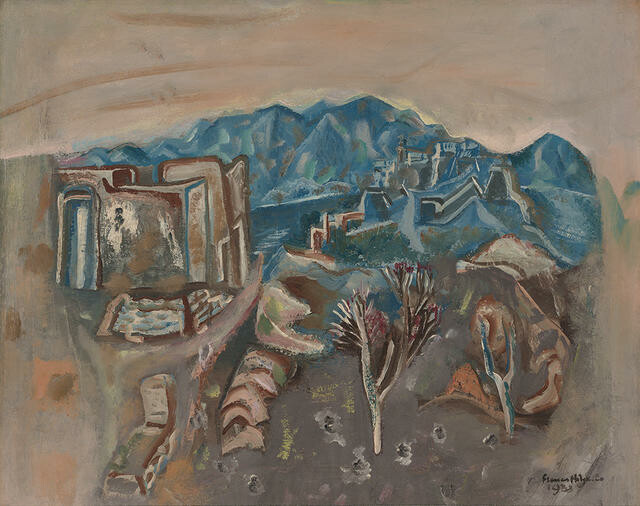Frances Hodgkins
Aotearoa New Zealand, b.1869, d.1947
Ibiza
- 1938
- Oil on canvas
- Purchased, 1979
- 736 x 874mm
- 79/419
Tags: abstraction, buildings (structures), landscapes (representations), mountains
Brought to light, November 2009- 22 February 2011
Hodgkins visited Spain several times throughout the 1930s, spending time at Ibiza and Tossa de Mar. On one visit to Ibiza, where the weather often swung drastically between huge storms and blue skies, she mentioned in a letter to the artist Karl Hagedorn that: ‘… in this clear ivory light every object looks important & significant – I wonder what you would make of subjects up here – things appear in stark simplicity minus all detail – nothing corked up (bouchée) or hidden as in the grey, or brown light of the north.’
Exhibition History
Frances Hodgkins was drawn to the climate and ‘clear ivory light’ of the Mediterranean. Spending six months on the Spanish island of Ibiza in 1933, renting ‘a smallish, badly lit room where I paint and sleep’, she celebrated the possibilities of the location, writing on arrival to a friend that ‘[t]he pale coloured flat roofed houses without windows give a blind restful feeling, of immense space’. Of the distinctive light she wrote, ‘things appear in stark simplicity minus all detail’.
In subdued colours, this Ibiza landscape – which Hodgkins completed in England in 1938 – displays her unique style of painting that emphasised the simplification and abstraction of forms. Hodgkins was regarded at this time as one of Britain’s leading painters.
Born in Dunedin, Hodgkins took lessons with G. P. Nerli (1860–1926) in 1893 and then studied at the Dunedin School of Art. In 1901 she left to study at the London Polytechnic. In 1903 Hodgkins exhibited at London’s prestigious Royal Academy, the first New Zealander to have the honour of being ‘hung on the line’. Living in Paris between 1908 and 1912, Hodgkins taught at the Académie Colarossi, the first woman on the staff there. Hodgkins travelled between New Zealand and Europe until 1913 when she settled in England. Throughout her career she exhibited with many art groups and galleries.
Quotations from letter to Karl Hagedorn, 29 January 1933, in Letters of Frances Hodgkins, edited by Linda Gill, p.456. (Opening Gallery hang, 2003)
It is not known for certain where this is but it may be a Welsh scene, inspired by one of two trips to Wales Frances Hodgkins took in 1938. Hodgkins has used subdued colours and has simplified elements in the landscape to their basic forms. Towards the end of her career, when this work was completed, Hodgkins developed a unique style of painting that emphasised the simplification and abstraction of forms. Born in Dunedin, Hodgkins took lessons with G.P. Nerli (1860 -1926) in 1893 and then studied at the Dunedin School of Art. In 1901 she left to study at the London Polytechnic. In 1903 Hodgkins exhibited at the Royal Academy, the first New Zealander to have the honour of being ‘hung on the line’. Living in Paris between 1908 and 1912, Hodgkins taught at the Académie Colarossi, the first woman on the staff there. Hodgkins travelled between New Zealand and Europe until 1913 when she settled in England. Throughout her career she exhibited with many art groups and galleries.
(Label date 2002)

